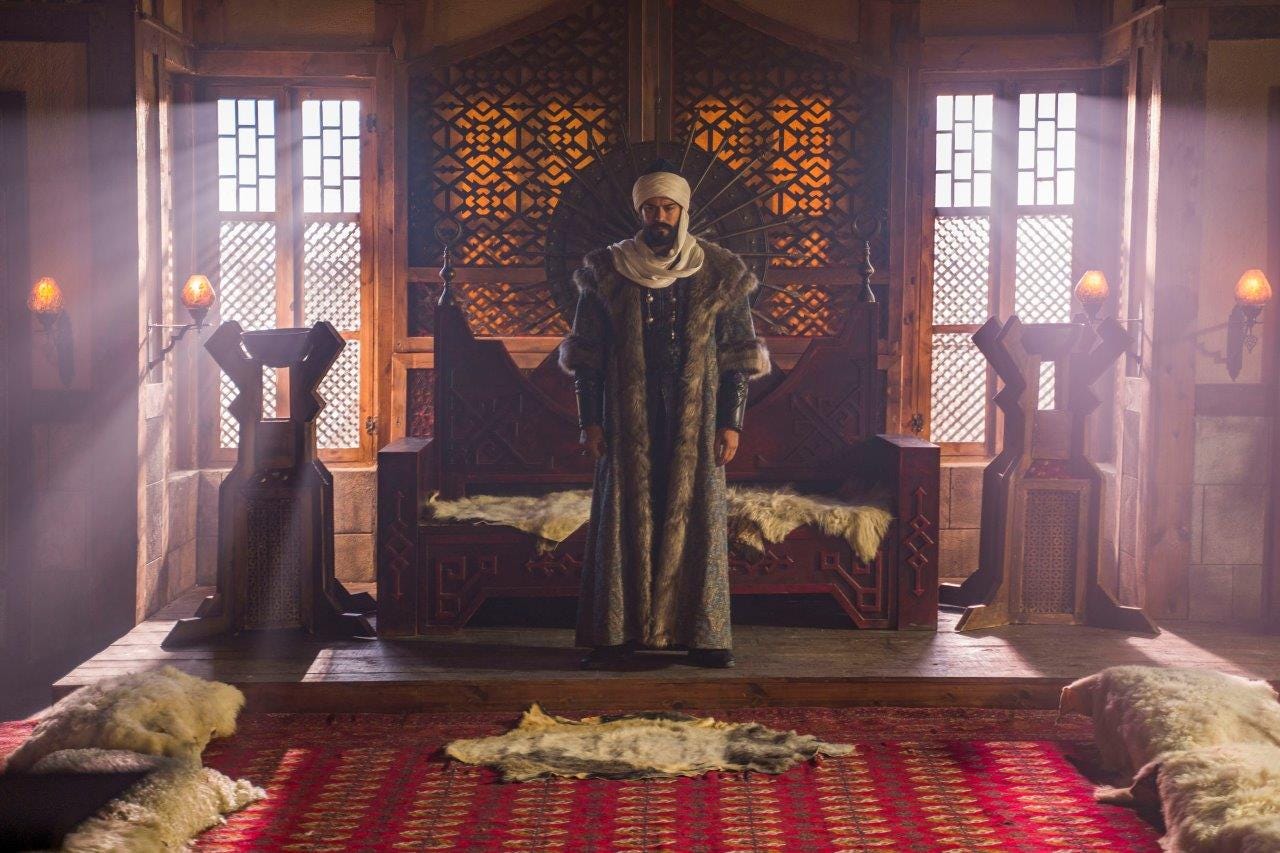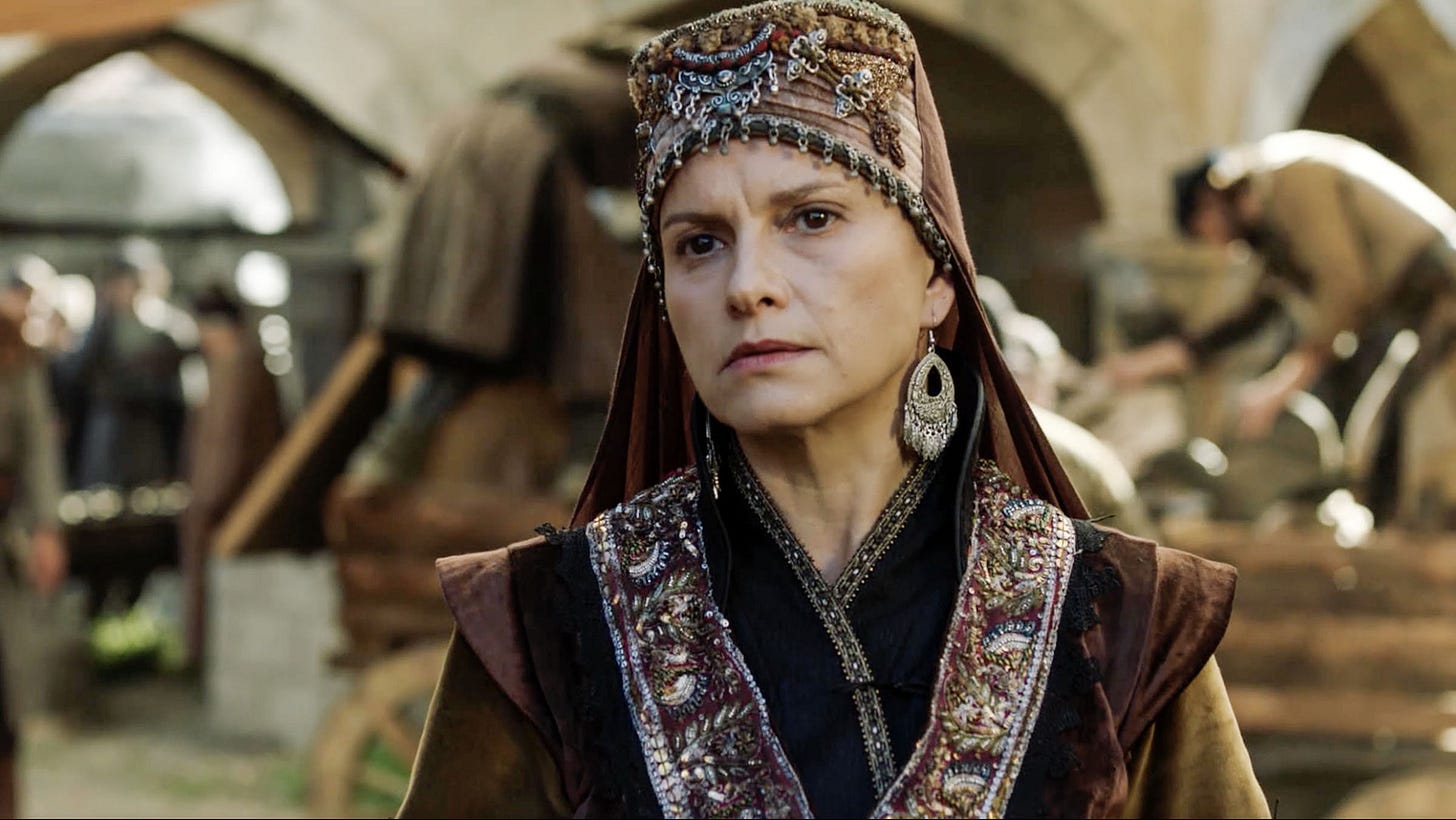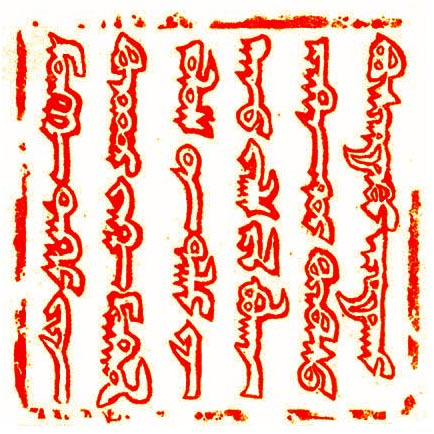A New Season of "Kuruluş: Osman" Has Begun
a post of mostly language-related observations, and the Naming of the Seas
Wow, what a beginning! Kuruluş: Osman S04E01 (or 99. Bölüm in the alternate numbering) was broadcast on Wednesday night, with new episodes to follow weekly as usual. Here’s the trailer (Youtube link), if you haven’t seen it.

Osman is moving up in the world; he has declared his empire and apparently now lives in a conquered stone building instead of a tent, and he has his sights set on Constantinople (which features a suitably bloody Colosseum).
The following is a list of a few interesting things I noticed while watching this week’s episode. We have a bunch of new characters, with new names to learn (of course the subtitles translation robot mangles these in the usual funny ways), and best of all, some new “ye olde” Turkish words. Past here there be spoilers. Lets take a look!

1. İpek Karapınar has a new job
I must admit, one of the things I was most looking forward to with the new season was seeing İpek Karapınar (who played Çolpan Han in Destan)1 in her new role. Turns out she’s playing a Viking!
The Vikings are going to be loads of fun this season. They are already raving about dining at Odin’s table in Valhalla and hitting things with axes, exactly as we expect them to do. Not knowing when exactly the Vikings made it as far as Anatolia and quickly Googling it, I’ve now learned about the Varangian Guard; mostly Vikings from Sweden, these guys were hired to serve as the Byzantine emperor’s personal guardsmen as they lacked the political loyalties of the local soldiers.
2. Mr. Binder and Mrs. Pingy
Sometimes the poorer-quality subtitles transcription/translation robots feel the need to “translate” Turkish-sounding names into something more English. This season the newly introduced characters of Bayındır Bey (played by Deniz Hamzaoğlu) and Bengi Hatun (played by Almila Uluer Atabeyoğlu) are excellently renamed in the subtitles I was using2 as “Mr. Binder” and “Mrs. Pingy”.
In Turkic mythology “Bayındır Han” was a legendary Khan who gets a lot of respect in the stories for generally keeping the peace and spreading civilisation, and my source3 says his name may have even been earned by others as a title.

The name “Bengi” comes from an old Mongolian word “Möngke” meaning “eternal”. More than that though, this word is used as an attribute of the Sky-God Tengri, so it would have been full of meaning as a name at the time. See the signature of Güyük Khan (pictured) which begins with the following words (reading down from the top of the column on the left hand side):4
Möngke ṭngri-yin küčündür
(Under the Power of the Eternal Heaven)

“Möngke” was even a suitable name for a ruler, for example Güyük Khan’s own son “Möngke Khan”, whom we know quite a lot about through his interactions with the Flemish explorer William of Rubruck.
So do I find the venerable histories of these fine Turkish names fascinating and awesome? Yes! Will I still refer to this character as “Mrs. Pingy” for as long as I live? Absolutely!
3. Ülgen Hatun’s accent
After the sad loss of Aygül at the end of Season 3, fan-favourite comic-relief character Cerkutay is being set up with someone new. Her name is Ülgen Hatun; she likes to cook and he likes to eat, so we know they are destined to be together.
“Ülgen” is another name with a fascinating history, being associated with the Turkic/Mongol deity “Bai-Ülgen”; creator of all, patron god of shamans, and source of their knowledge.
But I’m not here to talk about that; instead I have a question I don’t know the answer to (Update: now I do. See below). Watch this scene5 where Cerkutay corrects Ülgen's pronunciation of his name. He says "Cer - ku - tay"; but she voices her plosives, saying "Cer - gu - day". My question is, what accent is she meant to be portraying? If she is meant to be a local from the newly conquered Byzantine city of Yenişehir, she could have a Greek accent I suppose. I have no idea what that would sound like, but the Wikipedia article on Greek phonology does mention deletion/reduction of /t/ and /k/. I will award one Internet Point to anyone who can tell me the answer in the comments.

Update (26 Nov 2022): Officially, Ülgen's accent is from Kayseri. See this interview where she talks about the various accents she tried, starting around 2:15. English subtitles are hard-coded in.
4. New Old Turkish Words for the cardinal directions
The modern Turkish words for the compass directions are simply carried through from older Turkic languages, all fairly obvious sun-related terms:
“East” is “doğu”, meaning “(sun)rise”
“West” is “batı”, meaning “(sun)set”
“North” is “kuzey”, meaning “shady”
“South” is “güney”, meaning “sunny”
The Ottomans also used direction words loaned from Arabic, and these were still in use until fairly recently. Here’s Osman,6 with a line from this week's show that Youtube's translation skips altogether:7
Şarkta Moğol garpta Roma. İki taraftan da üzerimize gelirler.
(Mongols to the east, Rome to the West. They will come at us from both sides)
“Şark” (“east”) and “garp” (“west”) seem to be more commonly understood in modern times, compared to the other two Arabic-derived cardinal directions “şimal” (“north”) and “cenup” (“south”). Most Turks would know “garp” simply because it is in their national anthem:
Garbın afakını sarmışsa çelik zırhlı duvar,
Benim iman dolu göğsüm gibi serhaddim var.(If the steel armored wall surrounds the horizons of the West,
I have a borderline like my faithful chest.)
This of course is similar to how most Australians only know the archaic word “girt” from our own national anthem:
Australians all let us rejoice,
For we are young and free;
We’ve golden soil and wealth for toil,
Our home is girt by sea;
“Şark” (“east”) seems to still be in use in some limited ways. Wiktionary gives the example “şark expresi” (“orient express”). The şark/garp pair is either more frequently used in historical dramas or more noticeable than şimal/cenup though; I’ve never seen the latter come up, but here is şark/garp in a line8 in Alparslan: Büyük Selçuklu:
Bizim menzilimiz şark değildir
Garptır ağabey(Our destination is not east
It is west, brother)
Edit: A few more episodes of Alparslan: Büyük Selçuklu and I’ve now seen şimal/cenup on more than one occasion, I was probably just not noticing them previously. Here are all four Arabic directions carefully enunciated over a couple of sentences:9
Biruni Hazretleri’nin büyük mancınıklarını, Vaspurakan kalesinin şimal garp cenup yüzlerindeki üç kuvvetsiz mevkiye mevzilendireceğiz. Küçük mancılıklarınız okçu kuvvetlerimiz ve dahi ordu ağırlığımız şark cenahında mevzilenecek.
(We will deploy Al-Biruni’s large catapults on the three unprotected sides north, west and south of Vaspurakan castle. The small catapults and archers will be deployed along with the bulk of our armies on the east side.
These Arabic-derived Ottoman words are all fine and good, but the most interesting direction-words are the really old Turkic ones. This blog has a pretty concise summary of the naming of the seas around Anatolia:
[…] the Turkish language associates different colours with the four directions. The North is thought of as black (kara), the East is associated with the Turkish colour gök, which is a sky blue or turquoise, the South is seen as red (kızıl, a rusty shade of red) and the West is associated with the colour white (ak). What is interesting in Turkish is that the seas surrounding the Turkish peninsula and Anatolia take their names from these colour associations: the Mediterranean, which is west of Turkey, is called Akdeniz, or the White Sea, the Red Sea is Kızıl Deniz, and is located to the south of Turkey (its name is said to come from the rust-coloured sediments flowing into it) and the Black Sea, or Kara Deniz, is north of Anatolia (the Black Sea is also rich in iron sulfides, where only sulphur bacteria can thrive, and its sediments are dark).
The same colour/direction associations are found in Chinese culture, reflecting a likely common origin. Indeed, Rüdiger Schmitt suggests that the ancient colour/direction symbolism is so “widely attested”1011 that the idea expressed in the quote above, that the Black/Red seas were named for sediment colours, is just a modern urban legend. Schmitt puts his money on the Achaemenids as the earliest settlers who would have used the colour/direction naming system.

As these colour/directions are pre-Islamic, they aren’t mentioned on Kuruluş: Osman to my knowledge. But keep your eye out when watching shows like Destan that are set in earlier periods. A quick search brought up a couple12 of examples13 in episode 22 (Youtube-generated Turkish subtitles):
Kızılyan'daki orman yolunda kervanlarımızı pusuya düşürüp tüccarlarımızı katletmişler.
(Our caravans on the road in the forest on the Red Side were ambushed and our merchants slain)
and:
Kızılyanda ve ön kapıda bütün Gökmen sayıları artırılsın.
(All Gökmen numbers should be increased on the Red Side and at the front gate.)
The “Kızılyan” here is the red or south side of the kingdom.
To watch Turkish shows with subtitles, see my post here. Destan and Kuruluş: Osman are both available for free on ATV’s Youtube channel.
Destan was sadly cancelled after a single season, apparently due to low ratings and problems with the story. Since then the show won “Best Serial Drama” at the 17th Seoul International Drama Awards, sharing the award with another Turkish series Mahkum. These winners were selected by a panel of international judges from a field of 225 entrants from 39 countries. I remain forever salty about the loss of this show, and I will not be quieted.
Note the subtitles I was using (now disabled) were the very first to be released on OpenSubtitles for this episode, and are therefore of rather poor quality. The automated Youtube subs, which always take a few days to be generated after each episode goes up, are of much higher quality, and you should use those instead.
Edited 05Feb2023: “right hand side” was corrected to “left hand side”
Kuruluş: Osman 99. Bölüm; timestamp 38:58
Kuruluş: Osman 99. Bölüm; timestamp 30:32
The transcription into Turkish is good, but the translation to English in general is pretty bad this week for some reason.
Alparslan: Büyük Selçuklu 16. Bölüm; timestamp 30:39
Alparslan: Büyük Selçuklu 24. Bölüm; timestamp 2:03:03
I wanted to check Schmitt’s source for this statement as cited in the Encyclopaedia Iranica article, but couldn’t get a copy: its J. Knobloch, Sprache und Religion I, Heidelberg, 1979.
Hat tip to the article at Language Log which has more discussion; also the first comment there which led me to Encyclopaedia Iranica.
Destan 22. Bölüm; timestamp 32:57
Destan 22. Bölüm; timestamp 55:08



